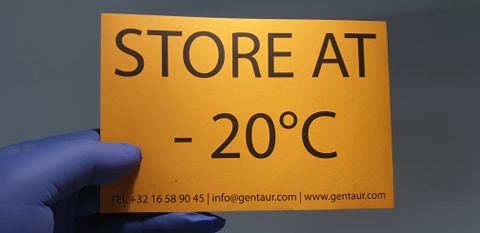Proteins need specific conditions to maintain their conformational, stability and activity characteristics . Unfavorable conditions or sudden changes in the protein’s native environment can lead to the protein being degraded, denatured or precipitated.
In this post we will review the factors that influence the stability of proteins, as well as some guidelines to know how to store proteins optimally, thus avoiding their degradation.
Factors Influencing Protein Stability
1.- Buffers : the pH of the solution containing the protein plays a fundamental role in its stability.
2.- Reducing environment : many proteins contain cysteines with free thiol groups, which in case of oxidation can generate the loss of biological activity of the protein.
3.- Ionic metal contamination : to avoid ionic metal contamination, a chelating agent may be added to the buffer (eg EDTA), except in those cases where the activity of the protein requires the presence of divalent metal ions.
4.- Hydrophobicity : in the case of less soluble proteins, such as membrane proteins, additives can be added to facilitate dissolution and prevent degradation.
5.- Proteases : they can lead to protein precipitation and / or loss of functionality.
7.- Temperature : temperature influences bacterial growth and the activity of proteases and other degrading agents, making it another factor that directly influences protein stability.
How To Store Proteins To Avoid Their Degradation
When the need arises to store a specific protein for a certain period, it is necessary to ensure that both its structural integrity and its activity are not altered over time. The optimal conditions for the storage of each protein may vary in each specific case, but there are a series of general recommendations that will help us to know how to store proteins to avoid their degradation.
1.- TEMPERATURE
In general, proteins can be stored under 4 temperature conditions:
- Lyophilized at room temperature
- Refrigerated at 4ºC
- Frozen at -20ºC
- Deep frozen at -80ºC or in liquid nitrogen
Let’s see the advantages and disadvantages in each case:
- Lyophilized at room temperature
- Allows long-term storage (years)
- Advantages : Prevents the chemical and hydrolysis degradation of the protein, as well as bacterial contamination, and facilitates transport and storage by being stable at room temperature.
- Disadvantages : Lyophilization requires specific equipment, not all proteins can be lyophilized, and at the time of use require an additional reconstitution step.
- Refrigerated at 4ºC, in solution
- Allows short-term storage (2/3 weeks)
- Advantages : Freeze-thaw cycles are avoided and the sample is ready to be used at the time of the test.
- Disadvantages : It is more prone to degradation by bacterial contamination, proteolysis and / or oxidation.
- Frozen at -20ºC, in solution with cryoprotectants
- Allows medium term storage (1 year)
- Advantages : Resists bacterial contamination and degradation by proteases and oxidation.
- Disadvantages : By having to add cryoprotectants, the total concentration of the protein is diluted.

- Deep frozen at -80ºC or in liquid nitrogen
- Allows long-term storage (years)
- Advantages : Contamination is avoided, and it is not necessary to add additives such as cryoprotectants or antibacterials.
- Disadvantages : Repeated freeze-thaw cycles can degrade the protein, so it is essential to aliquot the sample before deep freezing. (Remember this entry on Freeze-Thaw Cycles and Sample Degradation )
2.- PROTEIN CONCENTRATION
Diluted proteins (below 1mg / mL) are more prone to degradation, so it is always recommended to store proteins in the highest possible concentration .
In case the protein of interest is at a very low concentration and there is no possibility of concentrating it, auxiliary proteins such as BSA can be added to protect from possible degradations.
3.- ADDITIVES
There are several additives that can be added to proteins in solution to increase their stability, such as:
- Cryoprotectants such as glycerol or ethylene glycol that prevent the formation of crystals by freezing proteins, preventing them from degrading their structure.
- Protease inhibitors to prevent protein proteolysis.
- Antimicrobial agents (eg sodium azide) to inhibit bacterial growth.
- Chelating agents to prevent oxidation of thiol groups induced by metal ions.
- Reducing agents such as DTT or 2-mercaptoethanol to prevent oxidation of cysteines.

